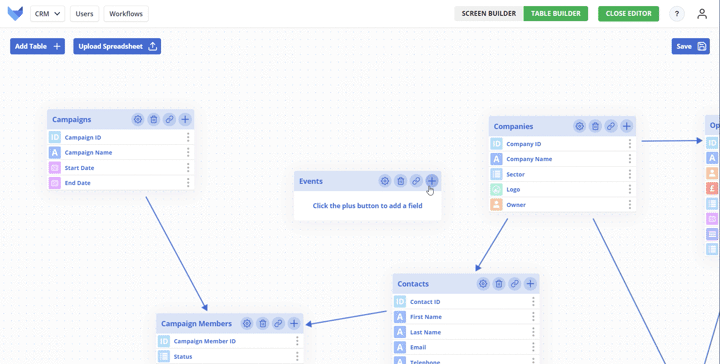
Visibility is a key element of the work we do. As projects grow, ensuring visibility across all of your data becomes even more important.
Gridfox is a no-code platform that enables users to gain maximum oversight over their data. The explorer feature is an essential part of this process which allows users to not only gain visibility over their information, but to also link existing tables together.
Explorer is one of the first tools that users can choose between when starting a new project, alongside the screen builder. These tools each offer a different user interface, which means that you can tailor your view to fit the needs of your project.
Alternatively, Gridfox offers a wide selection of templates to choose from, if you’re looking for some inspiration when beginning your project.
Once you’ve set your project title, you will be brought to the explorer page, where you can add tables and further fields to these tables. Tables can be thought of in the same way that worksheets in a spreadsheet are; they contain fields that are made up of data that you wish to track.

When tables are configured, you’re then able to view this data as an end user by heading to user mode — as is the case with projects that use the screen builder. If there are any tables in the navigation that you do not want your users to see, you can change the display of the Screen using the Screen Builder.
With all the relevant data visible, you can begin linking your tables, a feature that makes Gridfox an extremely powerful and useful tool for analysis.The two main table relationships types that Gridfox operates with are parent-child and many-to-many relationships.
A parent-child relationship is used for when you have a single parent record with many child records. For example, when using Gridfox as a CRM system, you can navigate between records and find relevant information such as contacts, projects and opportunities.
This is because a relationship has been created between the projects table, the company table and the opportunities table, etc. Viewing this in the editor shows you that the company table will have a child contacts table.
On the other hand, you might construct a many-to-many link between a customers table and a products table if you’re using Gridfox as a sales database. What this means is that each customer can buy many products and each of those products can be bought by many customers.
Or maybe you want to use Gridfox as a recruitment tracker which follows the progress of different applicants across stages of the interview process. Here, there are many different applicants who are interviewed by many different interviewers. To illustrate this relationship on Gridfox, you may wish to create three tables:
Linking Tables allows you to connect records to one another, providing a more useful representation of your company data. Both of the table relationships that are outlined here support the structure of your project by letting you gain critical insight into data structures and relationships.
Explorer is an essential components of Gridfox’s no-code platform, enabling users to create sophisticated applications without any previous coding experience.
Want to find out more? Get started with Gridfox for free here.